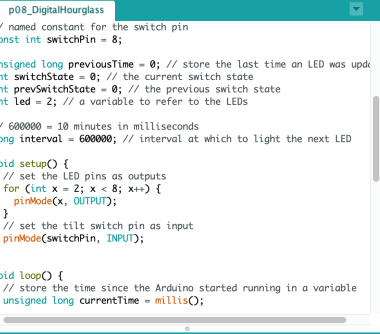Arduino IDE for Windows

Arduino IDE is a free integrated development environment that lets you program your Arduino board. The boards are considered microcontrollers units instead of computers and also called MCU systems. You can write your code in the Arduino software to upload it to the microcontroller. You can download Arduino IDE for Apple Mac, Linux, and Microsoft Windows PC operating systems.
NetBeans IDE, Atmel Studio, PlatformIO, and Visual Micro are development environments that are used by professional developers. The applications are more elaborate than Arduino. While Arduino IDE has remained relatively the same since the release, the alternatives programs have received impressive updates.
Does Arduino IDE use C++?
Arduino IDE uses C or C++ functions as the programming languages. The functions that you write will be compiled into the actual C or C++ scripting languages. You will use the IDE to write functions that get turned into full code to upload, since the Arduino board is coded in C or C++.
What language is the Arduino IDE?
The Arduino IDE is an open-source platform that codes in C, C++, and Java. You can modify the program within the terms of the GPL or LGPL license requirements. The source code is available in GitHub.
User guide
Arduino has a vibrant community that post tutorials to help users. You can use the forum like a guide to get started. The official website links you to the Discord and Project Hub pages to connect with Arduino users.
Why is Arduino IDE used?
Arduino is popular since the IDE is user-friendly and used to feed code to your board. Your microcontroller can interpret the inputs to determine the outputs. Environmental variables will let the board know what to do and the instructions continuously loop. The latest version includes code completion and search.
The user interface has a clean design. The menu and toolbar are in the top portion of the UI. The verify and upload buttons are the first two buttons in the toolbar. The serial monitor will appear at the bottom of the screen after you press the upload icon. Most of the screen is dedicated to the sketch script where you can use syntax highlighting to rename words.

The boards are selected using the ‘Tools’ tab in the menu bar. You will need to select the correct board from the large list to upload your sketch. While Arduino IDE is specifically designed for Arduino microcontroller units, you can use the utility with alternative MCU systems.
The ‘Preferences’ window lets you submit a JSON file to use non-Arduino boards. Another important part of the ‘Preferences’ area is the ‘Editor Quick Suggestions’ option. Commands and variables will be suggested to you while you type when you mark the quick suggestions box. The auto code completion feature lets you complete projects quicker. You can search for specific words within your sketch.
You can replace words with one another. Arduino IDE includes a list of libraries to choose from. The libraries include codes that let you complete specific types of projects, and you can install new libraries easily. You can click on the ‘Install’ button beside the preferred library to get the new code.
Room for improvement
While Arduino IDE includes debugging, this feature is not complete as you can only use the debugger with select boards. The developers have not released an ESP32 support. However, since Arduino IDE is open source, the community can develop the program to include an ESP32 debugging compatibility.
A certain level of risk is associated with the debug command since the development is incomplete, and very little documentation is available for you to review about the debugger. An additional complication with Arduino IDE is that the auto-completion feature will occasionally mislabel a portion of the syntax.
Our take
Arduino IDE is user-friendly, can be used with a variety of operating systems and microcontroller units, and is safe to use. You can verify the security of the platform by looking into the source code. The developers are steadily releasing new software updates that make improvements to the user experience. The most recent release includes code completion and debugging capabilities.
Should you download it?
Yes. If you are a developer that works with various MCUs, then yes this software is a good option since the program can safely adapt to boards.
Источник:










